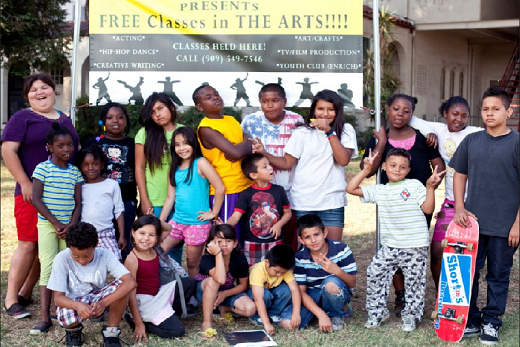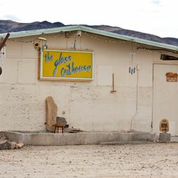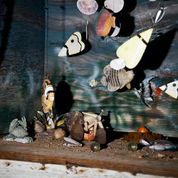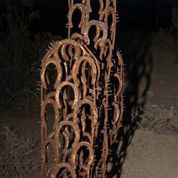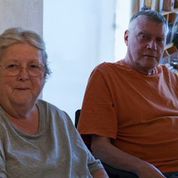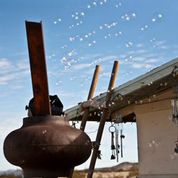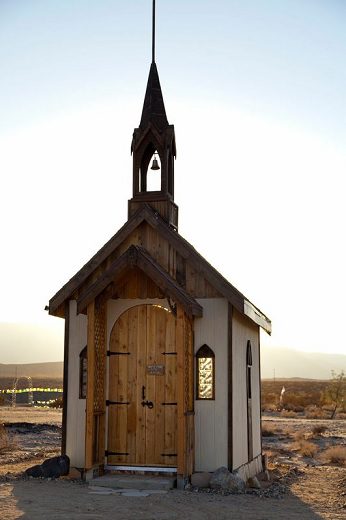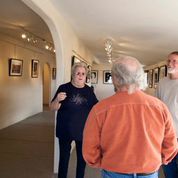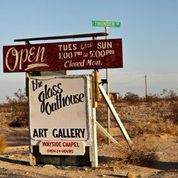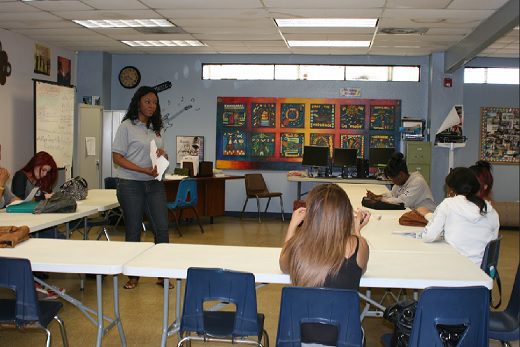
Photo credit: Esther J. Lee

Photo credit: Esther J. Lee
Using the arts to uplift, heal, and empower the community is the mission of LJR Arts Academy, which takes its name from the woman who single handedly runs it– Lynnzora J. Rogers. A compassionate, talented teacher and mentor dedicated to helping at risk youth of San Bernardino County, Ms. Rogers has great aspirations for providing essential art programs to the county.
I had the opportunity to speak with Ms. Rogers at PALS Center about LJR Arts Academy, its beginnings and bright future. Towards the end of our visit she introduced me to Mr. Radden, the CEO of PAL Center, who spoke to me briefly about the collaboration between the school and the burgeoning arts organization.
Esther: What was the inspiration behind this program? How did you get started?
Lynnzora: I started in 2004 when I was a Cal State San Bernardino student. I was very involved there with the student union program board and my sorority. I thought about doing a talent show and having the two organizations that I was a part of collaborate together. So as a liaison between the two groups, we pulled off a huge talent show. It was a perfect collaboration because the sororities were the networkers who brought in the crowd, and the program board had the money to fund it. A professor of mine who I asked to be a judge for the talent show saw me perform (dance), and she knew about my work as a substitute teacher, so she approached me about working for the Home and Neighborly Service; they were looking for a dance teacher at the time.
Esther: What is the Home and Neighborly Service?
Lynnzora: They are a community service that had a grant at the time to provide health related activity- in this instance dance- to the community. They only had two students, and I took the time to develop a curriculum and promote it on my own. Eventually the two students became fifteen, thirty, sixty– in about a month. It grew so rapidly. We started with hip hop dance, and it just was a hit. Afterwards the kids were so enthused and ready for the next thing, so we decided to perform for the public. The day of the performance it was raining, but it was still packed, and the radio station came down as well. I just don’t believe in doing anything at the minimum. I believe in putting everything you can into what you do. After six months the program ran out of grant money, but at that time they were hooked, and they were calling me about pursuing other opportunities.
Esther: So, much like you did with the talent show that you coordinated for the University, you were able to popularize this community program and bring a lot of people together.
Lynnzora: Yes, and the thing that changed it from just a job to the idea that “this is something that I’m meant to do” came after a specific incident. I released the kids and locked up the facility after class, and probably about 15 minutes later, I saw one of my students on the side of the road with their family. It was a family of four kids, and they were in their van with their mom just sitting there. I checked up on them and their mom proceeded to break down and explain their situation, which was that their father had recently left them and that they were homeless. I was confused, because they had just come earlier to class where the kids were smiling and having a good time dancing. I was concerned that the mother perhaps didn’t have resources, so I offered her numbers to call and places to go, but she explained to me that “the kids had everything taken away from them that mattered,” and that there was a lot of things they couldn’t do anymore. This program was the one thing that was free, that they enjoyed, and that they could do. She couldn’t take that away from them too.
Esther: That is powerful- that the dance class could provide the children with that kind of support. So this experience solidified for you the importance of the arts.
Lynnzora: It was one of those moments that you feel needed and you see what it does, (the arts). The kids going through all this- they are hungry and they are homeless, they come to my classes and it gets them through. That is why I started looking at the arts as something bigger than dance, or the act of doing, and as something therapeutic. A lot of my kids are in the center of drama in the community. A few of my students had to deal with their brother getting shot and killed in front of them, and their mother had the same attitude– I have to keep them doing something and involved.I have seen the arts get a lot of my kids through things. I’ve had students write monologues about their experiences, and present them, and it’s healing.
Esther: So you realized that you were meant to do this, and you saw how it made a difference. From being a teacher at the Home and Neighborly Service, when and how did LJR form?
Lynnzora: We started to do a lot of activities at that community center and I began getting many requests about starting a non-profit. The community center was doing their own thing and going through a change of management so my program was really standing alone. Eventually in 2008 the board of directors gave me their support to continue to do my work which was engaging the community on an integral level. So, that’s when LJR Arts Academy began.
Esther: What challenges have you been met with, either in the past or currently?
Lynnzora: Around 2010 when we became an official non profit, the executive director of the board who actually recruited me, she passed, and with that we underwent a lot of changes. A lot of programs were cut. We became homeless. The nonprofit didn’t have a place anymore. Around that time we started looking into a larger capacity building so we could become a stronger organization- I knew the arts side but I needed to know the business side. I started at the Aspire Academy and that’s when I met Linda Peterson, who is with St. John’s Episcopal Church. She immediately offered LJR Arts a home at the church, so since 2010 we have had our base there and we offer classes to that community now.
Esther: So LJR is currently mobile.
Lynnzora: We have been mobile, and in the past at different locations. St. John’s is our primary location currently, but we have had other locations as well. These are all places that have other purposes, like community centers. One of our goals, in the future, is to have a home base that we can call our own. The availability of a long-term space has been an issue. If a location has another event going on, then we can’t hold class. Having a regular reliable and stable environment for our students is crucial, and we have lost students because of that.
Esther: How does The PAL Center fit in with this?
Lynnzora: The PAL Center is a charter school, with teens from different backgrounds and stories. They are at risk youth, so this is huge for us! We are reaching the target population. It is the first time we are operating on campus and during the school hours with students getting elective credits. Working with the PAL Center is a huge stepping stone, and, like I mentioned, it is especially exciting for me because the goal was always to reach out to at risk youth- especially teens. So I feel that this was meant to be.
Esther: So this is a good segway into talking more about LJR Arts Academy’s biggest goals. What are your goals and how do you hope to achieve some of them?
Lynnzora: What I really want for LJR, at the PAL Center, is to bring in more resources in. The PAL Center is great because they recognize the importance of the arts, and it’s really cool because a lot of schools don’t- they are getting rid of the arts. My goal is to build an arts program, through LJR, on this campus. We have to start with the facility. We want to get a modular building that we can use for just the arts program. I would love to have one side to be a studio for our film class, and the other, an area for our dance class. Right now we share a space with another class in this multi-purpose space, and the students really need their own place. Teenagers are at an age when they are vulnerable and self-conscious. They need a safe environment, a safe haven, where they can express themselves without fear or judgement. I want to do it right. I want to make a difference. I want this to be the best, because the city needs it. These are the students that need it the most.
Esther: The funding is coming from the school?
Lynnzora: I have gotten grants for the PAL Center- the city of San Bernardino block grant- Southern California Edison, Wells Fargo- those are our current supporters. St. John’s Episcopal Church is of course also a big supporter.
Esther: Is there a way people can get involved?
Lynnzora: We can use donations from the community, our goal for the modular building is $50,000 for the PAL Center. If someone who has access to a big modular building can donate one- that would be amazing. Or, we need a location to call our own, and it’s sad because San Bernardino has so many abandoned buildings that are just not being used. If we had a permanent space, we would be able to have a really strong base for our classes, and students would be able to take root and grow. We could also use more support from the city. The Block Grant was a good start.
After my conversation with Ms. Rogers, I spoke with Mr. Radden, CEO of PAL Center. He provided insight into the larger picture for LJR Arts and its new base at the school campus. It is his great hope that the work Ms. Rogers does will be nurtured and grown into a successful model which can be implemented into other arts deprived San Bernardino schools.
Esther: What is the PAL Center?
Mr. Radden: The PAL Center has been around since 1984 as an institution. This location has been here since 2000. We have two programs operating– Workforce Investment Act, which provides 18-21 year olds with skills and job placements, and a Charter High School. The PAL Center is about challenging minds and changing lives, and there’s a long history of that in the community. We will continue to reach out to the community and other organizations to help us continue that legacy.
Esther: How did you become in contact with LJR Arts Academy?
Mr. Radden: I met Lynnzora, Ms. Rogers, through another organization that we are mutually involved in, and I saw that she was very talented and had some things that we could use at our school. I invited her to come work here and share her talents with our students, so that is how it all started.
Esther: What do you hope that students would take away from LJR Arts?
Mr. Radden: I hope students will take away a newfound appreciation for the arts, and understand how important it is to have arts in our society and culture. I think that Ms. Rogers is able to bring that to our students so that when they go out there they will have that understanding.
Esther: What are the goals you see for LJR Arts in terms of incorporating it into the PAL Center?
Mr. Radden: We’re looking down the road and we are hoping that the combination of what we have here, and what she is doing, grows to the point where we need to expand this whole project. Either to create a bigger facility, or provide an off site facility for our students– to offer them the full range of what LJR Arts can offer.
Esther: How can the community get involved?
Mr. Radden: When we have fundraisers- if the community can help through those mean to spread awareness and donate what they can. It’s important that we connect the dots between PAL, LJR Arts, and the parents. That would be the key thing.
Esther: It seems there are few non-profit organizations in the county that operate with the same mission as LJR Arts, which has a focus on at risk youth, or the youth in general.
Mr. Radden: There has been a lot of funding cut throughout the Inland Empire, all arts, schools, and after school programs. I think we miss and have gotten away from understanding how important the arts are to students and growth. That is why it’s important to have a program like LJR Arts where really there are none right now. The program is helping us change the culture for our campus.
Esther: Since she is the sole person behind this program and project, it would seem that down the road, if she can expand to other schools and other neighborhoods- that would be ideal.
Mr. Radden: I think that would be the key, to get herself set up here to the point where we can create a modular that we can drop into other schools and be able to say “Hey, this worked at the PAL Center, let’s try it out here.” I’m in support of that. We need different types of support, grants, and funding, so that her program is not just nestled here in Muscoy, it needs to be nestled all over San Bernardino.
For more Information about LJR Arts Academy and PAL Center check out:
http://www.ljrartsacademy.org/
https://www.facebook.com/LJRArtsAcademySanBernardino

